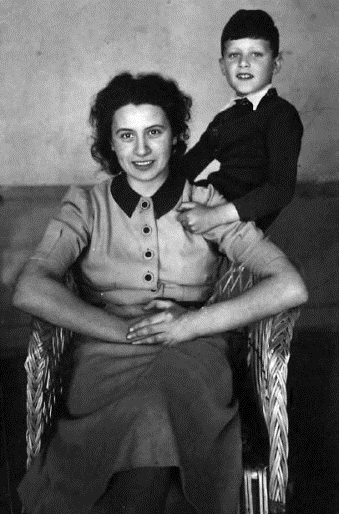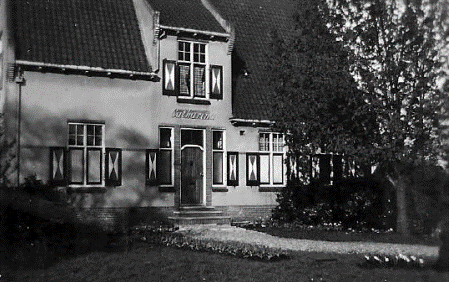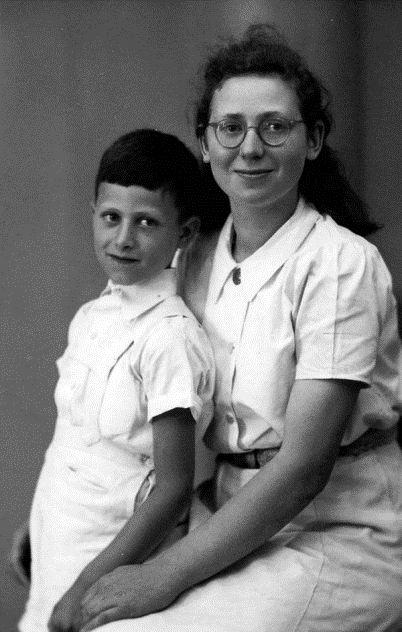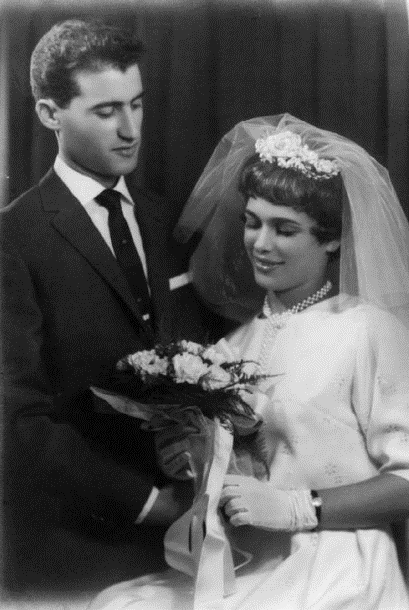Righteous Among the Nations- The Ten Berge Family
Gideon Lotan
"They didn’t do it for the money, but for the love of mankind alone"
Joseph (Sjef) and Mary ten Berge were devout Catholics who lived in Amersfoort, the Netherlands with their six children. Gideon Lotan, who spent the war years with the family, recounts that in 1943, his mother, Schoschana Litten, who was a Resistance fighter, left him with the Ten Berges and promised to visit him. Gideon was only six years old.
Joseph ten Berge was a wealthy merchant, and his wife, Mary, a schoolteacher; Lotan describes a deeply religious family with a strict approach to education. They took Gideon in as if he were their own. Since his looks stood out among the other children, he had to wear a hat to hide his dark hair whenever he was outside. Unlike the other Ten Berge children, Gideon couldn’t attend school, and Mary took it upon herself to teach him fundamental reading, writing and arithmetic skills.

Gideon Lotan and his mother, Schoschanna Litten, Gouda, 1943. From Ten Berge, Ellen. Een Kind Voor Mijn Deur: onderduik in Amersfoort, 2010.
After taking Gideon into their home, the Ten Berge family rescued a Jewish girl, Lida Lissauer. Lida was a student at the Jewish-Zionist farm school, operated by Gideon’s parents in Gouda. According to Gideon, preserving the Jewish tradition and customs was especially important to her. Together, they observed the Jewish holidays so as not to forget their original culture. Despite being devout Catholics, the Ten Berges never tried to force their religion on Gideon and Lida. They had to attend church on Sundays to avoid raising suspicion, but at home they could observe their Jewish faith. On one occasion, Joseph gave Lida an old Jewish prayer book with a silver spine, which he found at a close friend’s house.[1]

Catharinahoeve, The Hakhshara farm run by Gideon's parents in Gouda. From Ten Berge, Ellen. Een Kind Voor Mijn Deur: onderduik in Amersfoort, 2010.
In 1944, when the famine known as the Hunger Winter struck, it became increasingly hard to provide for the now-extended family. Joseph, distraught by the notion of being conscripted by the Germans, hid intermittently in their home’s bomb shelter. Lida would dress up as a Red Cross nurse and ride her bicycle into town to scour for food.[2]As Gideon recounts, the hunger was so severe that once, when a horse died on the street, people descended upon it, racing for a piece of meat. Lida’s excursions into town saved the Ten Berge family from starvation.

Gideon Lotan and Lida Lissauer, Amersfoort, 1944. From Ten Berge, Ellen. Een Kind Voor Mijn Deur: onderduik in Amersfoort, 2010.
When the Allied Forces’ bombers began appearing in the sky at the end of 1943, the Ten Berge family moved into their bomb shelter. Upon a respite in airstrikes the children would go outside to play, and find pamphlets, dropped by the Allied Forces to encourage and strengthen the Dutch people. Picking these up was strictly forbidden by the Germans, but the children would nevertheless collect them, if only to have something to read in the shelter. The airstrikes around them were so abundant that each of the children amassed a small collection of bomb shrapnel. Towards the end of the war, the Ten Berges also took in an Austrian deserter, who hid in their attic.
Shortly after the war ended, Shalom Weiss, a student from the Gouda farm school, came to take Lida and Gideon. In her journal, Mary ten Berge wrote that she wanted to adopt Gideon and had hoped that he would stay with them after the war, but she didn’t stop him from leaving. Gideon returned to the school in Gouda, where new students had arrived, but his parents never returned. Manfred and Schoschanna Litten were murdered in the death camps during the war. In 1946, Gideon received his visa and made Aliyah to Israel.
In June 1989, Joseph and Mary ten Berge were recognized by Yad Vashem as Righteous Among the Nations.[3]

Gideon and Dvora Lotan on their wedding day, Israel, 1963. From Ten Berge, Ellen. Een Kind Voor Mijn Deur: onderduik in Amersfoort, 2010.
Related Titles at Wiener Library:
טן ברחה, אלן ואירית באומן. ילד עומד על סף דלתי: מחסה באמרספורט. רעננה: דוקוסטורי, 2014.
Benjamin, Yigael, Edna Heruthy. They Were Our Friends : A Memorial for the Members of the Hachsharot and the Hehalutz Underground in Holland Murdered in the Holocaust. Tel-Aviv: Association of Former Members of the Hachsharot and the Hehalutz Underground in Holland-Westerweel Group Included Jerusalem, 1990.
Michman, Jozeph, Bert-Jan Flim, Israel Gutman, and Sara Bender. The Encyclopedia of the Righteous among the Nations: Rescuers of Jews during the Holocaust; The Netherlands. Jerusalem: Yad Vashem, 2004.
Schippers, Hans. Westerweel Group: Non-Conformist Resistance against Nazi Germany: A Joint Rescue Effort of Dutch Idealists and Dutch-German Zionists. Translated by R. J. Salfrais. Revised version of the Dutch edition. Berlin; De Gruyter Oldenbourg, 2019.





